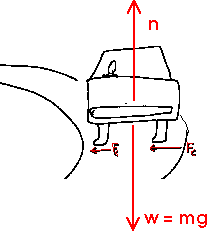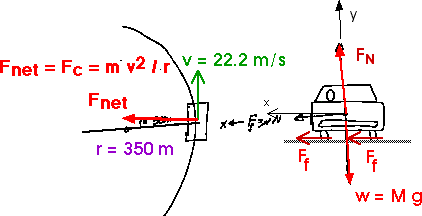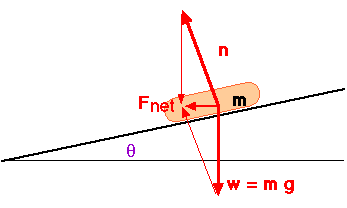

Motion on Curves
The net force on a car traveling around a curve is the centripetal force, Fc = m v2 / r, directed toward the center of the curve.
For a level curve, the centripetal force will be supplied by the friction force between the tires and roadway.
A banked curve can supply the centripetal force by the normal force and the weight without relying on friction.
Level Curves
For a level curve, the centripetal force will be supplied by the friction force between the tires and roadway.

Example What must be the coefficient of friction between the tires and the level roadway to allow a car to make a curve of radius r = 350 m at a speed of 80 km/h?
For a level curve, the force of friction is the only horizontal force on a car and provides the centripetal force. This can be seen from the free-body diagram:

The net force must be horizontal -- pointing toward the center of the circle -- and only the friction force is available to provide it. The normal force and the weight simply cancel each other.
Calculations are easier if the speed is expressed in m/s so we shall convert that first.
km 1000 m h v = 80 -- [------] [------] h km 3600 s v = 22.2 m/s Now we can calculate the necessary centripetal force,
Fc = M v2 / r (22.2 m/s)2 Fc = M ------------ 350 m Fc = 1.41 M (m/s2) FN = M g = (M) (9.8 m/s2)
For this flat curve, the centripetal force is supplied by the friction force, Ff,
Ff = FN
F f =
M 9.8 m/s 2
Ff = Fnet = Fc
M 9.8 m/s 2 = 1.41 M (m/s2)
= 0.141
Of course, any coefficient of friction greater than 0.141 will keep the car from slipping; this is the minimum value for
. Notice that the force of friction is perpendicular to the velocity. But it still is in the direction necessary to oppose the motion that would occur without friction. The car will slide away from the center (to the right in this diagram) if it encounters a patch of low-friction surface (like ice or oil); therefore the friction force is directed toward the center.
Notice, too, that we are dealing with static friction. The piece of the tire in contact with the road is momentarily at rest with respect to the road! The force of static friction is somewhat greater than the force provided by kinetic friction, if the tires start to skid.
Banked CurvesHow can a car ever travel at all on a slippery highway? Some curves are banked to compensate for slippery conditions like ice on a highway or oil on a racetrack. Below is a car making a banked turn. Without friction, the roadway still exerts a normal force n perpendicular to its surface. And the downward force of the weight w is present. Those two forces add as vectors to provide a resultant or net force Fnet which points toward the center of the circle; this is the centripetal force. Note that it points to the center of the circle; it is not parallel to the banked roadway.

Resolve the forces into their components. Since we are interested in the force that points toward the center of the circle, we choose a coordinate axis that lies along that direction. There is no acceleration in the y-direction so the sum of the forces in the y-direction must be zero.
Remember, the net force must point toward the center of the circle. It does not point down, along the surface. The net force on an object moving in a circle may also be called the centripetal force.

Fnet,y = n cos - w = 0
n cos
= w
n = w / cos
Fnet,x = n sin
Fc = m v2 / r
but
Fc = Fnet,x substituting, this provides
Fc = mv 2 / r = n sin = [w / cos
] sin

Fc = mv 2 / r = w [ sin
/ cos
]
Fc = mv 2 / r = w tan
m v 2 / r = m g tan
tan
= v 2 / g r
This gives the angle necessary for a banked curve that will allow a car to travel in a curve of radius r with constant speed v and require no friction force. A banked curve is designed for one specific speed. If the banked curve is icy so there is no friction force at all then traveling at higher than design speed means the car will slide out, up, and over the edge and traveling at lower than design speed means the car will slide in, down, and off the bank.


Return to ToC, Ch 6, Application of Newton's Laws (c) Doug Davis, 2005; all rights reserved